The Model Subregional Agreement on Transport Facilitation
The Model Subregional Agreement on Transport Facilitation has been elaborated on the basis of findings of comparative studies between major subregional agreements on transport facilitation to which various ESCAP member States are parties, conducted in 2014-2015. It has been subsequently reviewed by two regional expert meetings held in 2015 and finalized with incorporation of ESCAP member States’ comments.
Training Manual on Operational Aspects of Multimodal Transport
Acknowledging the importance of multimodality in enhancing the seamlessness of supply chain and logistics network for ESCAP member countries, including landlocked developing countries (LLDCs), the “Training Manual on Operational Aspects of Multimodal Transport” was developed as part of ESCAP Transport Division initiatives to improve technical knowledge of the transport and logistics sector and to support human resource development and capacity-building of ESCAP member countries.
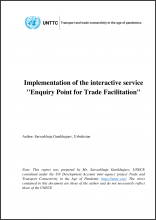
Uzbekistan: Implementation of the interactive service «Enquiry Point for Trade Facilitation»
Article 1 of the TFA obliges WTO members (and therefore all interested parties) to promptly publish information related to international trade, so that WTO members (and, accordingly, all interested parties) can familiarize themselves with the rules to ensure a transparent and predictable environment for international trade. WTO Members are encouraged to provide access to trade-related information via Internet and establish or maintain enquiry points (EP).
Currently, in the Republic of Uzbekistan, work is underway to bring national legislation in line with the requirements of the WTO Trade Facilitation Agreement (TFA).
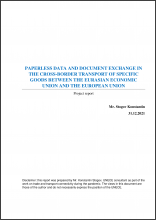
Paperless Data and Document Exchange in the Cross-Border Transport of Specific Goods between the Eurasian Economic Union and the European Union
In the context of the recovery from the COVID-19 pandemic and the general direction of building back better this project aims to develop and practically test paperless data and document exchange in the cross-border transport of specific goods between the Eurasian Economic Union and the European Union.
Focusing on a specific pilot case of multimodal delivery of goods author of this study conducted research and offered practical recommendations how to align used by different participants in the supply chain in their IT systems to the UN/CEFACT standards and Multimodal Transport Reference Data Model, allowing for a seamless exchange of electronic data and documents (B2B exchange), as well as developing electronic B2G documents for submission to regulatory authorities.
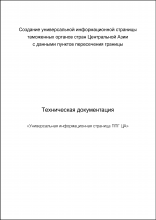
Technical Specification for Uniform Customs Information Page in Central Asia
This Standard describes the installation and set up procedures necessary to deploy a specified information page at the web-sites of the Customs authorities of the Central Asian countries. Such page would contain all relevant information on border checkpoints in a universal and easy-to-use form.
Both documents are prepared in Russian.
Настоящий Стандарт описывает процедуры установки и настройки, необходимые для развертывания и введения в эксплуатаци. специализированной информационной страницы на веб-сайтах таможенных органов центральноазиатских стран. Такая страница будет содержать соответствующую информацию о пунктах пересечения границы в универсальной и легкодоступной форме.
Оба документа подготовлены на русском языке.
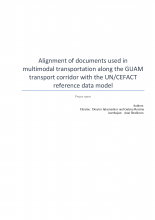
Alignment of documents used in multimodal transportation along the GUAM transport corridor with the UN/CEFACT reference data model
The objective of this project is further development of the digital transport documents that could provide seamless information flows accompanying cargo flows between countries along the GUAM transport corridor. Due to its position in the middle of the cargo transport routes between Europe and Asia, the use of UN/CEFACT standards and recommendations for cargo information sharing along this route makes much sense.
The focus of the project is on the practical application of the data models and standards to facilitate real-world transport operations that take place along this transport route. This is achieved by creating digital twins of real business documents that are mapped to the UN/CEFACT multimodal transport reference data model (MMT RDM) to ensure interoperability both in terms of changing jurisdictions and modes of transport along the route.
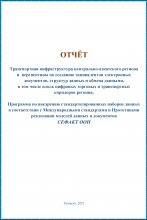
CA Transport Infrastructure and Perspectives on Development of Electronic Document Equivalents, Data Structures and Data Exchange
This Report serves as a preparation to the research of trade and transport corridors going though the Central Asia and establishes the necessity of digitalization of multimodal transport data as well as exchange of documents along those corridors through the use of UN & UN/CEFACT standards.
This Project is the joint initiative of the UNECE and the Ministry of Transport of the Republic of Uzbekistan.
The relevance of this project is the current common interest of all the countries in the region to jointly develop the transport links.
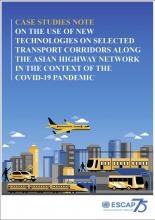
Seamless and smart connectivity along the Asian Highway network in the time of COVID-19
Freight transport operations poses the risks during the pandemics, especially if it is not fully computerized. As documents and goods continue to be subjected to physical checks for customs and other regulatory purposes, crew members and staff at border-crossing points and control terminals are exposed to the risk of contagion by the nature of their work. in this context, the use of information and communication technologies (ICT) and intelligent transport systems (ITS) is directly relevant to the pandemic response and recovery policies.Optimization of automation and digitalization can reduce the need for human interaction, making cross-borders transport safer and more resilient to disruptions. In this context, this technical note aims to offer policy recommendations for policy responses using new technologies and smart road solutions to preserve the regional transport connectivity in the time of the pandemics and other similar disruptions.
Training Manual on Logistics Information System
The “Training Manual on Logistics Information System” was developed as part of the activities of the UNDA project “Transport and trade connectivity in the age of pandemics: Contactless, seamless and collaborative UN solutions”.
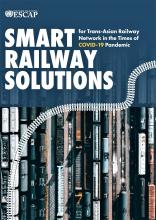
Smart Railway Solutions for Trans-Asian Railway Network in the Times of COVID-19 Pandemic
To support trade and transport connectivity globally in times of pandemic the United Nation agencies have jointly launched a project titled- Trade and transport connectivity in times of pandemics: with overarching objective of developing contactless, seamless and collaborative solutions to preserve and further enhance the trade and transport connectivity. In Asia and the Pacific, ESCAP is leading the project and has initiated series of studies aimed at supporting countries in this direction.
The present study on smart railway solutions has been carried out under the project with aim to identify smart railway solutions that are proven to be successful elsewhere and are potentially replicable and scalable. Not all solutions would have equal importance or relevance for the railways of the region.